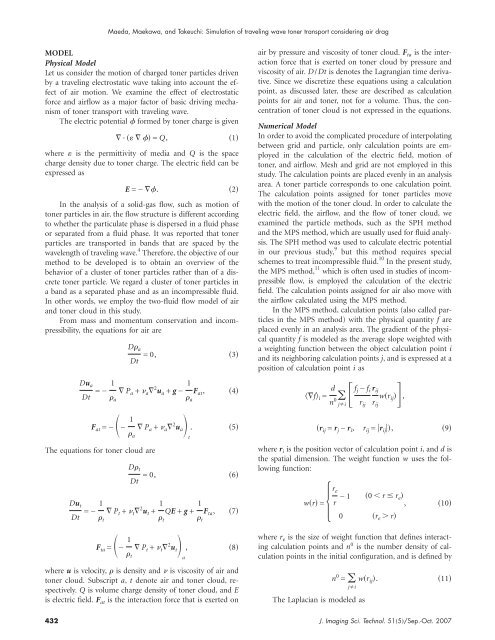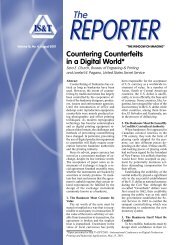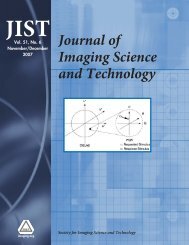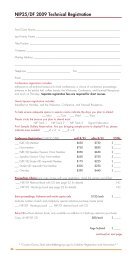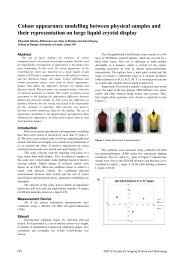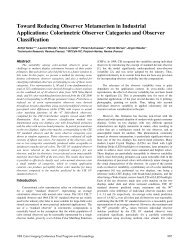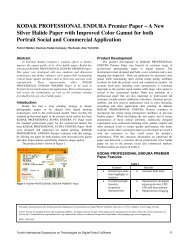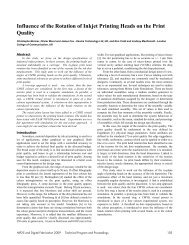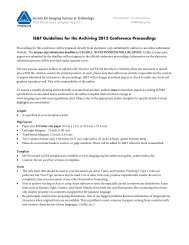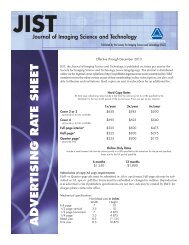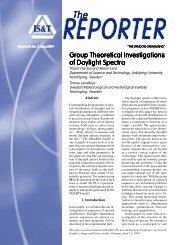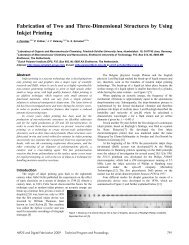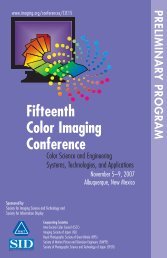JIST - Society for Imaging Science and Technology
JIST - Society for Imaging Science and Technology
JIST - Society for Imaging Science and Technology
Create successful ePaper yourself
Turn your PDF publications into a flip-book with our unique Google optimized e-Paper software.
Maeda, Maekawa, <strong>and</strong> Takeuchi: Simulation of traveling wave toner transport considering air drag<br />
MODEL<br />
Physical Model<br />
Let us consider the motion of charged toner particles driven<br />
by a traveling electrostatic wave taking into account the effect<br />
of air motion. We examine the effect of electrostatic<br />
<strong>for</strong>ce <strong>and</strong> airflow as a major factor of basic driving mechanism<br />
of toner transport with traveling wave.<br />
The electric potential <strong>for</strong>med by toner charge is given<br />
· = Q,<br />
where is the permittivity of media <strong>and</strong> Q is the space<br />
charge density due to toner charge. The electric field can be<br />
expressed as<br />
E =−.<br />
In the analysis of a solid-gas flow, such as motion of<br />
toner particles in air, the flow structure is different according<br />
to whether the particulate phase is dispersed in a fluid phase<br />
or separated from a fluid phase. It was reported that toner<br />
particles are transported in b<strong>and</strong>s that are spaced by the<br />
wavelength of traveling wave. 4 There<strong>for</strong>e, the objective of our<br />
method to be developed is to obtain an overview of the<br />
behavior of a cluster of toner particles rather than of a discrete<br />
toner particle. We regard a cluster of toner particles in<br />
a b<strong>and</strong> as a separated phase <strong>and</strong> as an incompressible fluid.<br />
In other words, we employ the two-fluid flow model of air<br />
<strong>and</strong> toner cloud in this study.<br />
From mass <strong>and</strong> momentum conservation <strong>and</strong> incompressibility,<br />
the equations <strong>for</strong> air are<br />
D a<br />
Dt =0,<br />
1<br />
2<br />
3<br />
Du a<br />
=− 1 P a + a 2 u a + g − 1 F at , 4<br />
Dt a a<br />
air by pressure <strong>and</strong> viscosity of toner cloud. F ta is the interaction<br />
<strong>for</strong>ce that is exerted on toner cloud by pressure <strong>and</strong><br />
viscosity of air. D/Dt is denotes the Lagrangian time derivative.<br />
Since we discretize these equations using a calculation<br />
point, as discussed later, these are described as calculation<br />
points <strong>for</strong> air <strong>and</strong> toner, not <strong>for</strong> a volume. Thus, the concentration<br />
of toner cloud is not expressed in the equations.<br />
Numerical Model<br />
In order to avoid the complicated procedure of interpolating<br />
between grid <strong>and</strong> particle, only calculation points are employed<br />
in the calculation of the electric field, motion of<br />
toner, <strong>and</strong> airflow. Mesh <strong>and</strong> grid are not employed in this<br />
study. The calculation points are placed evenly in an analysis<br />
area. A toner particle corresponds to one calculation point.<br />
The calculation points assigned <strong>for</strong> toner particles move<br />
with the motion of the toner cloud. In order to calculate the<br />
electric field, the airflow, <strong>and</strong> the flow of toner cloud, we<br />
examined the particle methods, such as the SPH method<br />
<strong>and</strong> the MPS method, which are usually used <strong>for</strong> fluid analysis.<br />
The SPH method was used to calculate electric potential<br />
in our previous study, 9 but this method requires special<br />
schemes to treat incompressible fluid. 10 In the present study,<br />
the MPS method, 11 which is often used in studies of incompressible<br />
flow, is employed the calculation of the electric<br />
field. The calculation points assigned <strong>for</strong> air also move with<br />
the airflow calculated using the MPS method.<br />
In the MPS method, calculation points (also called particles<br />
in the MPS method) with the physical quantity f are<br />
placed evenly in an analysis area. The gradient of the physical<br />
quantity f is modeled as the average slope weighted with<br />
a weighting function between the object calculation point i<br />
<strong>and</strong> its neighboring calculation points j, <strong>and</strong> is expressed at a<br />
position of calculation point i as<br />
f i = d <br />
n ji f j − f i r ij<br />
wr 0 ij ,<br />
r ij<br />
r ij<br />
F at =−− 1 a<br />
P a + a 2 u at. 5<br />
r ij = r j − r i , r ij = r ij , 9<br />
The equations <strong>for</strong> toner cloud are<br />
D t<br />
Dt =0,<br />
Du t<br />
Dt =− 1 P t + t 2 u t + 1 QE + g + 1 F ta ,<br />
t t t<br />
6<br />
7<br />
where r i is the position vector of calculation point i, <strong>and</strong> d is<br />
the spatial dimension. The weight function w uses the following<br />
function:<br />
e<br />
wr =r r −1 0 r r e<br />
, 10<br />
0 r e r<br />
F ta =− 1 t<br />
P t + t 2 u ta, 8<br />
where u is velocity, is density <strong>and</strong> is viscosity of air <strong>and</strong><br />
toner cloud. Subscript a, t denote air <strong>and</strong> toner cloud, respectively.<br />
Q is volume charge density of toner cloud, <strong>and</strong> E<br />
is electric field. F at is the interaction <strong>for</strong>ce that is exerted on<br />
where r e is the size of weight function that defines interacting<br />
calculation points <strong>and</strong> n 0 is the number density of calculation<br />
points in the initial configuration, <strong>and</strong> is defined by<br />
n 0 = wr ij .<br />
ji<br />
The Laplacian is modeled as<br />
11<br />
432 J. <strong>Imaging</strong> Sci. Technol. 515/Sep.-Oct. 2007


